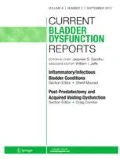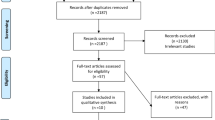Abstract
Validated questionnaires assessing incontinence and related symptoms along with their impact on quality of life are important for quantifying baseline burden of disease and response to treatment. Many tools have been developed for use in either a general incontinence population or for specific etiologies of incontinence and gender-based concerns. Knowledge of current instruments and the populations they were designed for is key for trial design and optimal clinical utility.
Similar content being viewed by others
References
Papers of particular interest, published recently, have been highlighted as: • Of importance
Milsom I. The prevalence of urinary incontinence. Acta Obstet Gynecol Scand. 2000;79:1056–9.
Donovon J, Badia X, Corcos J, et al. Symptom and quality of life assessment. In: Cordozo L, Khoury S, Wein A, editors. Incontinence: proceedings of the second international consultation on incontinence. 2nd ed. Plymouth: Health Publication Ltd; 2001. p. 267–316.
Avery K, Donovan J, Peters TJ, et al. ICIQ: a brief and robust measure for evaluating the symptoms and impact of urinary incontinence. Neurourol Urodyn. 2004;23:322–30.
Abrams P, Avery K, Gardener N, Donovan J. The International Consultation on Incontinence modular questionnaire: www.iciq.net. J Urol. 2006;175:1063–6. This article outlines the specific modules developed and validated for the ICIQ.
Nystrom E, Sjostrom M, Stenlund H, Samuelsson E. ICIQ symptom and quality of life instruments measure clinically relevant improvements in women with stress urinary incontinence. Neurourol Urodyn. 2014. doi:10.1002/nau.22657.
Sirls LT, Tennstedt S, Brubaker L, et al. The minimum important difference for the international consultation on incontinence questionnaire—urinary incontinence short form in women with stress urinary incontinence. Neurourol Urodyn. 2013. doi:10.1002/nau.22533. This is a subanalysis of the TOMUS trial and compares the ICIQ-UI SF with the UDI, IIQ, and PGI-I along with other secondary endpoints. It examines the minimal important difference for the ICIQ-UI SF that correlates with a women’s subjective sense of improvement after surgery for SUI.
Coyne K, Revicki D, Hunt T, Corey R, Stewart W, Bentkover J, et al. Psychometric validation of an overactive bladder symptom and health-related quality of life questionnaire: the OAB-q. Qual Life Res. 2002;11(6):563–74.
Stewart W, Herzog R, Wein A, on behalf of the NOBLE Program Research Team, et al. Prevalence and impact of overactive bladder in the US: results from the NOBLE program. Neurourol Urodyn. 2001;20(4), Abstract 24.
Ubersax JS, Wyman JF, Shumaker SA, et al. Short forms to assess life quality and symptom distress for urinary incontinence in women: the incontinence impact questionnaire and the urinary distress inventory. Neurourol Urodyn. 1995;14:131–9.
Lubeck DP, Prebil LA, Peeples P, Brown JS. A health related quality of life measure for use in patients with urge urinary incontinence: a validation study. Qual Life Res. 1999;8(4):337–44.
Susset JG, Gleason DM, White CF, Munoz D, Gittleman MC, Wachs BH, et al. Open-label safety and dose conversion/determination of once-daily OROS® oxybutynin chloride for urge urinary incontinence (U-UI). J Urol. 1998;159(5):36. Abstract.
Notte SM, Marshall TS, Lee M, Hakimi Z, Odeyemi I, Chen WH, et al. Content validity and test-retest reliability of Patient Perception of Intensity of Urgency Scale (PPIUS) for overactive bladder. BMC Urol. 2012;12:26. doi:10.1186/1471-2490-12-26.
Chapple CR, Drake MJ, Van Kerrebroeck P, Cardozo L, Drogendijk T, Klaver M, et al. Total urgency and frequency score as a measure of urgency and frequency in overactive bladder and storage lower urinary tract symptoms. BJU Int. 2014;113(5):696–703. doi:10.1111/bju.12555. A new instrument that may be more sensitive in detecting clinically relevant changes in urgency.
Chapple CR, Amarenco G, López Aramburu MA, Everaert K, Liehne J, Lucas M, et al. A proof-of-concept study: mirabegron, a new therapy for overactive bladder. Neurourol Urodyn. 2013;32(8):1116–22. doi:10.1002/nau.22373.
Rogers RG, Coates KW, Kammerer-Doak D, Khalsa S, Qualls C. A short form of the Pelvic Organ Prolapse/Urinary Incontinence Sexual Questionnaire (PISQ-12). Int Urogynecol J Pelvic Floor Dysfunct. 2003;14(3):164–8. discussion 168.
Girod I., McCarthy C., Marrel A., De La Loge C., Marquis P. Development and psychometric validation of a quality of life questionnaire in urinary incontinence. Abstracts presented to the 6th Annual Conference of ISOQOL, Barcelona, Spain, 3–6 November 1999. Qual Life Res 1999; 7:658.
Kelleher CJ, Cardozo LD, Khullar V. A new questionnaire to assess the quality of life of urinary incontinent women. Br J Obstet Gynaecol. 1997;104:1374.
Amarenco G, Arnould B, Carita P, Haab F, Labat JJ, Richard F. European psychometric validation of the CONTILIFE: a quality of life questionnaire for urinary incontinence. Eur Urol. 2003;43(4):391–404.
Donovan JL, Peters TJ, Abrams P, Brookes ST, de Rosette JJ, Schäfer W. Scoring the short form ICSmaleSF questionnaire. International Continence Society. J Urol. 2000;164(6):1948–55.
Donovan JL, Abrams P, Peters TJ, et al. The ICS-“BPH” Study: the psychometric validity and reliability of the ICSmale questionnaire. Br J Urol. 1996;77:554.
Donovan JL, Peters TJ, Neal DE, et al. A randomized trial comparing transurethral resection of the prostate, laser therapy and conservative treatment of men with symptoms associated with benign prostatic enlargement: the CLasP study. J Urol. 2000;164:65.
Tsang B, Stothers L, Macnab A, Lazare D, Nigro M. A systematic review and comparison of questionnaires in the management of spinal cord injury, multiple sclerosis and the neurogenic bladder. Neurourol Urodyn. 2015. doi:10.1002/nau.22720.
Patel DP, Elliott SP, Stoffel JT, et al. Patient reported outcomes measures in neurogenic bladder and bowel: a systematic review of the current literature. Neurourol Urodyn. 2014. doi:10.1002/nau.22673.
Compliance with Ethics Guidelines
Conflict of Interest
Christopher Zappavigna and Lesley K. Carr declare that they have no conflict of interest.
Human and Animal Rights and Informed Consent
This article does not contain any studies with human or animal subjects performed by any of the authors.
Author information
Authors and Affiliations
Corresponding author
Additional information
This article is part of the Topical Collection on Voiding Dysfunction Evaluation
Rights and permissions
About this article
Cite this article
Zappavigna, C., Carr, L.K. Validated Questionnaires for the Evaluation of Urinary Incontinence—Which, When and Why?. Curr Bladder Dysfunct Rep 10, 138–142 (2015). https://doi.org/10.1007/s11884-015-0290-y
Published:
Issue Date:
DOI: https://doi.org/10.1007/s11884-015-0290-y




